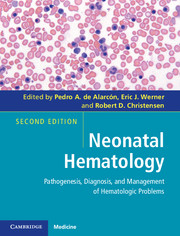Book contents
- Frontmatter
- Contents
- Contributors
- Foreword
- Preface
- 1 A historical review
- Section I Developmental hematology
- Section II Erythrocyte disorders
- Section III Platelet disorders
- Section IV Leukocyte disorders
- Section V Immunologic disorders
- 15 Immunodeficiency diseases of the neonate
- Section VI Hemostatic disorders
- Section VII Transfusional medicine
- Section VIII Miscellaneous
- Index
- Plate section
- References
15 - Immunodeficiency diseases of the neonate
from Section V - Immunologic disorders
Published online by Cambridge University Press: 05 February 2013
- Frontmatter
- Contents
- Contributors
- Foreword
- Preface
- 1 A historical review
- Section I Developmental hematology
- Section II Erythrocyte disorders
- Section III Platelet disorders
- Section IV Leukocyte disorders
- Section V Immunologic disorders
- 15 Immunodeficiency diseases of the neonate
- Section VI Hemostatic disorders
- Section VII Transfusional medicine
- Section VIII Miscellaneous
- Index
- Plate section
- References
Summary
Significant progress has been made towards the understanding of the clinical implications of the immature neonatal immune system. With the increasing survival of extremely premature infants, neonatologists and other physicians caring for these patients must be aware of the vulnerability of this patient population. It is important for neonatologists to be able to differentiate between immune immaturity and a true primary immunodeficiency that may present during the neonatal period. Failure to properly identify primary immunodeficiency diseases can result in delayed diagnosis and treatment, which can significantly affect the outcome of the disease. This chapter will briefly define the immune immaturity of the neonate. More specifically, the immune deficiency syndromes that may present during the neonatal period are discussed followed by a stepwise approach on how to properly diagnose and manage neonates with suspected immunodeficiency diseases.
Immaturity of the neonatal immune system
The immaturity of a neonate’s immune response places them at an increased risk for serious infection. An understanding of the development of the neonatal immune system is essential in order to be able to differentiate the clinical manifestations of infection associated with immaturity from those that identify a specific acquired or primary immunodeficiency disease. For further detail on the development of the immune system, the reader should refer to Chapter 3. The immune defects associated with immaturity and their associated susceptibility to specific types of infections are summarized in Table 15.1.
- Type
- Chapter
- Information
- Neonatal HematologyPathogenesis, Diagnosis, and Management of Hematologic Problems, pp. 255 - 276Publisher: Cambridge University PressPrint publication year: 2013

